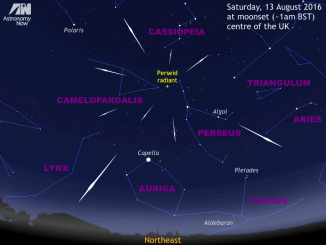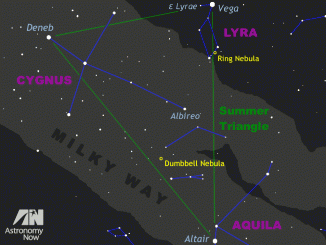
Observing


Jupiter and Venus get extra close in the evening sky
On Saturday 27 August at 22:32 UT (11:32pm BST), a spectacularly close conjunction occurs between Jupiter and Venus just 22 degrees west of the Sun in the constellation of Virgo, when the planetary pair are just 4 arcminutes, or one-fifteenth of a degree, apart. Here is our guide to the best locations and times to view this rare event.

See the triple lineup of Antares, Mars and Saturn tonight
Observers in the British Isles with a clear sky one hour after sunset on 24 August should find a location that offers an unobstructed view of the south-southwest horizon. Here you will see first-magnitude star Antares in the constellation Scorpius, Mars and Saturn all in a line easily encompassed by low-power binoculars in the bright twilight.

See asteroid 2 Pallas at its best during August 2016
During the Perseid meteor shower, second-largest asteroid 2 Pallas passed close to the southeast of globular cluster Messier 15 in the constellation of Pegasus. The minor planet still lies in the vicinity of this beautiful deep-sky object, reaching opposition on 20 August — here’s our in-depth guide to Pallas at its best.

Get ready for the Perseid meteor shower peak of 11-12 August
With a waxing gibbous Moon setting at 1am BST for the UK on the night of 12-13 August, observers will have dark skies for what could be a Perseid meteor shower to remember. Some theorists believe that Jupiter’s gravitational influence has deflected more particles from parent comet 109P/Swift-Tuttle into Earth’s path for a spectacular show.

See the International Space Station glide over the UK
If you chance upon a bright ‘star’ crawling across the sky in an arc from west to east, an object that doesn’t flash or possess red and green running lights (which is an aircraft), then you can be fairly certain that you’re looking at the International Space Station (ISS). Find out when and where to see it from the British Isles and Western Europe this week.

Seek out the celestial treasures within the Summer Triangle
At the beginning of August, keen observers in the heart of the UK can celebrate the return of truly dark skies around 1am BST. But the naked-eye stars are out by 11pm, and if you cast your gaze two-thirds of the way from southeast horizon to overhead at this time you can see the so-called Summer Triangle in all its glory. Here’s our guide to some of the celestial highlights therein.

Let the Moon be your guide to finding Neptune on 23 July
Outermost planet Neptune reaches opposition on 2 September 2016, this year marking the 170th anniversary of the gas giant’s discovery. But you don’t have to wait six week to observe the farthest known planet of the solar system, because the waning gibbous Moon drops close by in the small hours of Saturday, 23 July as seen from the British Isles.

See the Moon meet Mars and Saturn
In the bright evening twilight of 14, 15 and 16 July, observers in the British Isles and Western Europe can see the waxing gibbous Moon pass by Mars, first-magnitude star Antares in Scorpius, then Saturn. This series of conjunctions occurs very low in the southern sky for UK-based astronomers, while Australasian observers are ideally placed to view the spectacle almost overhead.

See the crescent Moon get close to Jupiter on Saturday, 9 July
If the excitement of the Juno spacecraft’s arrival at Jupiter has prompted you to seek out the solar system’s largest planet, then the 5-day-old cresent Moon acts as a convenient celestial guide during the evening of Saturday, 9 July when it makes a close pass of the gas giant. Here’s our guide to where and when to see this beautiful celestial pairing.
